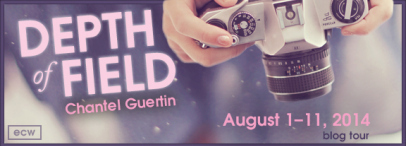E. Kristin Anderson's Blog, page 18
August 8, 2014
7 Questions I Always Ask +1: An Interview with Chantel Guertin
Chantel Guertin is blog touring all over the Internet in support of her new novel, DEPTH OF FIELD, the sequel to THE RULE OF THIRDS, which I adored. I’m so excited to have her here to answer my seven questions…and one just for her about writing her character Pippa Greene.
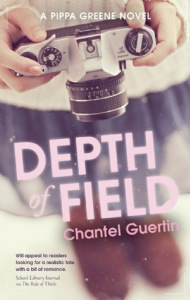
ECW Press, August 2011.
E. Kristin Anderson: What was the first spark of inspiration for your latest novel
Chantel Guertin: DEPTH OF FIELD is Book 2 in the Pippa Greene series, which started with THE RULE OF THIRDS. The series follows Pippa, a 16-year-old photographer who’s dealing with the death of her father from cancer. My mom died when I was a teen, and I found it really hard to deal with her illness and death, and also just be a teen and see my friends. I wanted to write a novel that dealt with the death of a parent, and blended sadness with humor.
EKA: What kind of planning do you do before you start writing?
CG: I brainstorm what I want the book to be about. That’s usually just a page long. Then I start writing scenes, and then piecing it together and seeing where the story goes, then filling in the missing links. I don’t always even know how it’s going to turn out until I’ve written a first draft!
EKA: If you could have lunch with any writer living or dead, who would it be?
CG: I would love to meet John Green. I’ve loved his writing since LOOKING FOR ALASKA.
EKA: What is the first book you remember reading and enjoying as a young reader?
CG: A few of my favorites, which I read over and over again: ARE YOU THERE, GOD? IT’S ME, MARGARET., STARRING SALLY J. FRIEDMAN AS HERSELF, STRANGER WITH MY FACE, the Anne of Green Gables and Emily of New Moon series.
EKA: If you could go back and time and tell your teen self ONE THING AND ONE THING ONLY, what would it be?
CG: Stop worrying about what anyone else thinks.
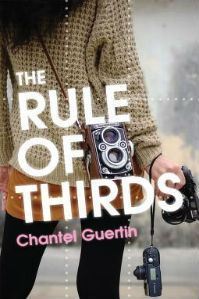
ECW Press, October 2013.
EKA: If you haven’t had a book challenged or banned, would you want this to happen to you? Why or why not?
CG: I realize that if one of my books were to be banned it’s because there may be something inappropriate for teens in it, and I don’t want to be that bad-ass who’s corrupting the youth of tomorrow, but at the same time I loved and love many books that get banned, and so I do secretly want to have a book banned! Sometimes the reason books are being banned seem totally ridiculous, and at the same time make teens really rally behind a book if they love it. And who doesn’t want that? With THE RULE OF THIRDS, a reviewer warned that that there was underage, unsupervised drinking, and I thought, Yessssssss. One step closer. I’m kidding, kind of.
EKA: What kind of book do you really want to try to write, but haven’t ever attempted? And what do you think is holding you back?
CG: A choose your own adventure! But I just don’t know if it would ultimately be that rewarding to write. It might be a fun project for Wattpad, to get feedback from readers about what they want along the way!
EKA: What was it like writing a sequel for Pippa? Easier than the first book? Harder? Fun? Scary? Give us all the dirt!
CG: I loved writing the sequel but it was also a lot harder than I thought it would be. Originally I’d planned out the whole series (which right now is supposed to be 4 books) but when I started writing DEPTH OF FIELD, I got so caught up in the characters that the story totally changed! I don’t want to give any spoilers but one major change was that in an early draft, Dace and Dylan were both in New York with Pippa! You can imagine how differently the book might’ve turned out than the way it is now. The same thing is happening with Book 3, which I’m working on right now. Even I have no clue how it’s going to end!

Chantel Guertin
Chantel Guertin is the bestselling author of four novels—STUCK IN DOWNWARD DOG, LOVE STRUCK, THE RULE OF THIRDS and DEPTH OF FIELD–and a beauty expert on The Marilyn Denis Show. When she’s not working on a new book she likes writing in her diary, sending mis-autocorrected texts to her best friends and making to-do lists. She lives in Toronto, Ontario.





August 7, 2014
Review: THROUGH THE WOODS by Emily Carroll
There are beautiful books, and then there’s THROUGH THE WOODS by Emily Carroll.
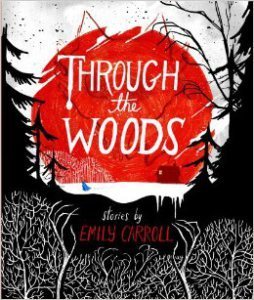
Margaret K. McElderry, July 2014.
I haven’t read anything like this before, and perhaps this is because I don’t read as many books in graphic format as I used to, but it could also be that THROUGH THE WOODS is breaking ground. It’s a collection of short stories told in a combination of illustration and text. It has the look and feel of a graphic novel, but there’s also a but more text than you’d find in a typical comic. So, I’m going to think of it as a hybrid. A beautiful, beautiful hybrid.
In THROUGH THE WOODS, Emily Carroll explores some serious spooky folklore. I’m pretty sure that there’s a death in every single one of the shorts. Her use of color — and limited palette — is stunning and evocative. And, because she’s using the folktale/fable trope, you do see a bit of a “moral” to every story. But often that moral ends up going awry, which is absolutely delicious.
If you’re the type of reader who flocks to fairytale retellings but who is also often disappointed by these retellings’ lack of teeth and bones and bumps in the night, I am throwing this book at you. THROWING IT. Because you must read it. With the light off, under the covers, with a flashlight. Just do it. And thank me later.





August 6, 2014
Review: SAY WHAT YOU WILL by Cammie McGovern
You know how every year there’s that one contemporary YA that no one will shut up about and sometimes you’ve already read it and you’re like “Hell yeah, I read that, high fives!” and sometimes you haven’t and you’re like, “Damn, I’d better go get that book. Last year it was ELEANOR AND PARK by Rainbow Rowell. This year, so far as I can tell, it’s SAY WHAT YOU WILL by Cammie McGovern.
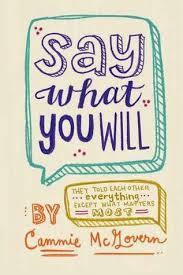
Harper Teen, June 2014.
Here are some things that I love about SAY WHAT YOU WILL:
1. The voice. Especially since it’s partially narrated by a character who is perceived as not having a voice, as she is a nonverbal teen with pretty severe cerebral palsy.
2. The respectful and truthful depictions of two disabilities: cerebral palsy and OCD (obsessive compulsive disorder).
3. The fact that two people with the above disorders have a romantic connection. And their feelings for each other are authentic and real and are outside of what disability means and have everything to do with what being a human teenager means.
4. The fact that the above-mentioned people are whole people, are funny and sad and strange and full of personality. The illnesses are not the characters. The people are.
5. The writing. THE WRITING! Cammie McGovern knows how to grab you by the gut, and she doesn’t need a lot of words to do it.
6. Everything. So much everything.
If you like books like ELEANOR AND PARK, like LOOKING FOR ALASKA (people have been comparing this to THE FAULT IN OUR STARS, but I think the illness theme makes this an easy comparison), like SPEAK — these books that become iconic because of their lyrical truths, well, you’l just adore SAY WHAT YOU WILL. Go get it and read it so that you can start telling everyone how amazing it is.





August 5, 2014
Review: THE VANISHING SEASON by Jodi Lynn Anderson
This is the first book I’ve read by Jodi Lynn Anderson — an author who has definitely established a foothold in contemporary YA. And what I loved about this book — aside from its authenticity, the so-real-you-can-see-your-breath-in-the-cold setting, the striking voice — was that it bends the rules of contemporary YA. And it bends them kind of hard. And it works.
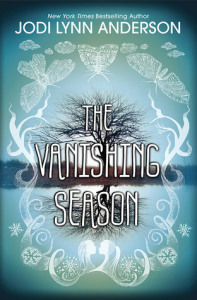
HarperTeen, July 2014.
THE VANISHING SEASON takes place in rural Wisconsin. And by Rural I mean there’s no cell reception, everyone knows everyone, and everyone is part of a population that is maybe three digits. Maggie, the protagonist, lives on a street where she only has two neighbors — beautiful Pauline and her hot, male, friend-zoned bestie, Liam. Each of Maggie’s new friends comes with some serious baggage. Pauline’s rich family was left devastated after the death of her father, and Liam’s dad is the town Atheist. Maggie misses Chicago, but she lets herself fall into these new friendships, spending all of her time with Pauline and Liam when she’s not working on her homeschooling or at the town’s antique dealer, where she’s employed by the most gossipy woman she’s ever met.
But even in the beautiful setting of Door County, on this gorgeous lake, Maggie’s idyllic small town is shattered by the news of missing — and dead — girls. The events shake up everyone. Maggie’s boss has a list of suspects (pretty much everyone), but it doesn’t make anyone feel safer. If anything, it gives folks a bit of a sick thrill. And another unnamed narrator — that of a long gone girl — is there to watch it all unfold.
This book is beautiful and strange and impossible to put down. With both elements of mystery and the first sparks of romance, THE VANISHING SEASON is the kind of book that leaves readers breathless. I can’t wait to see what Jodi Lynn Anderson does next.





July 31, 2014
Everything You’ve Learned About Writing is a Lie
Okay, so maybe not everything. But there’s a lot of stuff that I remember learning in middle and high school that turned out to not actually work for me — or for pretty much anybody — as a writer. I’m hoping that if I can lay these lies out for you, we cans turn it around and unlearn some of these bad habits. Because, man, nothing says “noob” like practicing some of these frequently-taught faux pas.
Lie #1: Be super duper descriptive!

Wait, wait, I know what you’re thinking. Descriptive language is good, right? You want your reader to know what you’re talking about, and to be able to see, smell it, hear it, touch it, taste it the way you do in your head. The problem is that, when it comes to description, a little bit goes a long way. Sometimes, it’s about finding a better word to use, instead of a string of adverbs and adjectives to go with your verb or noun. You know, you could say “She skulked through the forest” instead of “She walked sneakily through the heavily-wooded area.” See what I mean? Now, that’s kind of an obvious one, but when you go to write, here’s a good trick to keep in mind: modifiers are evil. They are sneaky and they will slip into your poetry and prose without you even noticing. Your job, as a writer, is to keep an eye on those things.
Modifiers — like adverbs and adjectives — are words that describe other words. They should be used sparingly. Otherwise, you’re going to have a mess on your hands. When you’re writing, always ask yourself, do I need this word? Or is there something simpler and equally descriptive that I could use here?
SO HERE’S THE TRUTH: Use descriptive language and sensory details, choosing words carefully. Every word you put on the page should be a word that NEEDS to be there.
Lie # 2: Show off your vocabulary!

Some writers I’ve run into have a penchant for tossing around five dollar words. It’s almost as if they want the reader to know that they totally nailed the vocab section on their SATs. The thing is, creative writing isn’t about what you know, it’s about telling a story in the smoothest way possible. So why use “loquacious” if you could say “chatty?” Think about how your narrator or point-of-view character would think and speak. Think of how the people around you speak. If you can’t imagine someone using that word in a conversation, it’s probably a no-go. When it comes to five-dollar words, they should be sprinkled, not poured, into your writing.
SO HERE’S THE TRUTH: If you want your writing to feel authentic, use authentic language. Use those five dollar words sparingly!
Lie #3: Spice up your speech tags!

Here’s the thing about speech tags: They should be invisible. The reader should pretty much not notice them at all. I mean, there’s a reason that you sometimes don’t even need them — like in an extended conversation between two characters. There are pretty much only two speech tags you will ever need: “said” and “asked.” (You can, and should, of course, alter the tense as needed.) You may be able to slip in a “screamed” or a “replied” here and there, but sticking to the basics is always the better option. You don’t want your reader getting hung up on speech tags when she should be paying attention to the conversation and the story.
Another word on speech tags: Using simple tags like “said” and “asked” doesn’t give you carte blanche to start throwing adverbs around. “She said, angrily” or “he asked, jokingly” is just as much of an offense as not using a simple speech tag. If someone is speaking angrily or jokingly, that should show in the words they’re using, and in the body language in the scene. This is a great case of “show, don’t tell,” which, thankfully, is a lesson from school that you can hold onto.
SO HERE’S THE TRUTH: You will hardly ever need to use words other than “said” or “asked.”
Lie #4: Poetry is about your feelings!

No. Poetry is about expressing yourself, sure — just like any other writing. But it’s not about emotions. It’s about saying something. It’s a narrative between the poet and the reader, and it should be full of images and ideas, not simply the thoughts you would write in your journal with some line breaks thrown in. Yes, poetry — just like any other writing — can be emotional. But your job as the writer isn’t to emote onto the page. It’s to get your reader to emote. Again, this is a place where that whole “show, don’t tell” thing comes in handy.
SO HERE’S THE TRUTH: Poetry isn’t about any one thing. And all writing should evoke emotions. Use your excellent writing skills to make the reader feel!
Lie #5: Capitalize the beginning of every line in your poem!

This is actually an antiquated form. If you’re reading poetry — and if you’re writing poetry, I hope you are! — you’ll notice that contemporary poets only capitalize where they would in a regular sentence. So lines can start with lowercase letters. You capitalize when you start a new sentence, or for proper nouns — all the usual suspects. But when you start a new line, and the previous line didn’t end with a period, no, you don’t need to capitalize. In fact, I’d recommend sticking to the new way of doing things. We both know you’re not Shakespeare, after all.
SO HERE’S THE TRUTH: Sure, you can capitalize every line, but it’s going to make you look old-fashioned. And not in a trendy way.
Lie #6: Practice writing by writing!

This is actually half true. Yes, you do get better at writing by writing. But you know what’s even better? Reading. A well-read writer is going to be a way better writer than a writer who writes every day but never reads. I promise you, this is a fact.
SO HERE’S THE TRUTH: If you’re not reading as well as writing, you’re doing it wrong.
Lie #7: A haiku is 5-7-5!

Yikes! They really stepped in it with this one. Sure, some haiku these days are 5-7-5, but usually these are referred to as senryu, since they are Westernized and have less to do with nature and brevity and more to do with cramming something into that syllabic format, often with a humorous twist. There’s a lot of information out there about haiku, but I’ll leave you with this: Writing haiku is more about brevity and observing nature than it is about an exact syllable count.
SO HERE’S THE TRUTH: Haiku isn’t about the syllables. Do some research and figure out what style of haiku works for you!
Lie #8: The classics are the right way to learn writing!
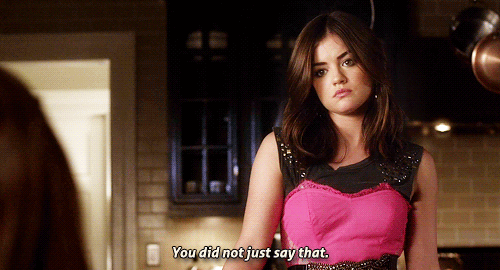
Sure, the classics are great. But if you want to write for contemporary readers (like, you know, alive people), it’s a good idea to read contemporary work! Enjoy some Emily Dickinson, but make sure you’re also checking out Louise Gluck. Feel free to curl up with J.D. Salinger, but don’t forget about Jennifer Egan. And, you know, there’s lots to be discovered in your local library or bookstore — not just the bestsellers. Read widely across genre and author background. Read books you like and books you don’t like. Just make sure you’re reading, and reading more than the tried and true golden oldies.
SO HERE’S THE TRUTH: If you want to improve your craft, read lots of genres and DEFINITELY check out your contemporaries!
Lie #9: Only write what you know!

If this were true, we wouldn’t have, I don’t know, any fantasy. Or space operas. Or historical fiction. Sure, it takes a lot of imagination and even more research, but writing outside of your comfort zone can be a good thing. Writing what you know can keep you grounded, and using your life experience to keep your writing honest is an excellent idea. But talking to people with different experiences from you, and reading about other lives and other ideas, and imagining schools for young wizards…well, these are all great tactics for writing richer stories.
SO HERE’S THE TRUTH: Start with what you know, use your imagination and your ability to do research to take your writing to the next level.
Lie #10: You’re a genius!

Don’t pretend someone in your life hasn’t told you this. Someone along the line — a mother, a teacher, a friend — has probably read your writing and told you that you’re going to be a New York Times best-selling author. And it felt good, I bet. But, you know what? If it’s someone like a parent, a teacher, or a friend, they might be looking at your writing through rose-colored glasses. And you need someone who’s going to be tough on you if you want to improve and have any chance at being a capital A Author. Are you a genius? Maybe. But don’t take this “lesson” at face value.
SO HERE’S THE TRUTH: If you don’t work hard and seek critical feedback, and learn to take critical (and negative) feedback, you probably won’t succeed no mater what kind of talent you have.
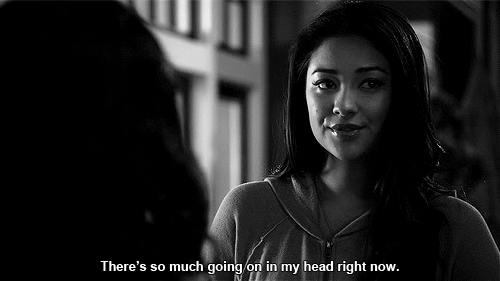
Got questions? Leave ‘em below! There are exceptions to every rule, and there are plenty of rules that might not make sense, which is why talking to other writers is always helpful. (Another lie: Writers can only be successful when they are holed up in a cabin in the woods somewhere.)
This post is cross-posed from the deviantART.com #CRLiterature & #ProjectEducate blogs. We’re exploring literature basics this week, so feel free to mosey on over there for some fun tutorials. And thanks to the #CRLiterature team for suggesting the idea for a post. I think the above liars would approve. 






July 29, 2014
7 Questions I Always Ask +1: An Interview with Candace Fleming
I’m psyched to have Candace Fleming on my blog today for my new interview series, “7 Questions I Always Ask, +1.” Candace’s latest book is THE FAMILY ROMANOV, and I’m delighted to share her insights into Russian history, writing historical fiction, a brush with censorship…and more!
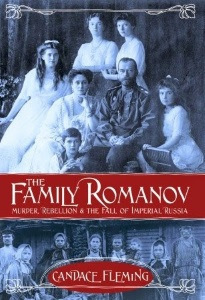
Schwartz & Wade, July 2014.
E. Kristin Anderson: What was the first spark of inspiration for your latest book
Candace Fleming: Curiosity sparked THE FAMILY ROMANOV. Mine, as well as that of dozens of middle schoolers. Let me explain. I first read Robert Massie’s Nicholas and Alexandra the summer between my 7th and 8th grade year after pulling it off my mother’s bookshelf.
“You’re not going to like that,” she warned. “It’s pretty dense history.”
She was right. It was dense, but I loved it! Imperial Russia (and its demise) intrigued me. I was hooked! And that sense of curiosity has stuck with me over the years. I’ve read dozens of books on the topic. I’ve watched documentaries and gone to museum exhibits. And I can recite – seriously -whole passages from Dr. Zhivago.
But I’d never considered writing about the Romanovs until five years ago. That’s when students in middle schools – mostly girls — suddenly started asking if I knew anything about Anastasia Romanov. I would visit a school and invariably during the question-and-answer period of my presentation a hand would start waving wildly in the air. No matter than I’d come to talk about people from American history. Time and again I found myself talking about Tsar Nicholas II’s youngest daughter. Why the sudden interest in Anastasia? I finally got the answer from them. They’d seen the animated movie, Anastasia, and they realized it was based on a nugget of truth. But what was that truth? They longed to know. And they hoped I could tell them. Sadly, in the little time allotted, I really couldn’t… not enough anyway. And so I began to conceive of a book for them. THE FAMILY ROMANOV is my answer to those middle schoolers’ questions.
It’s also the answer to mine. Once I decided to write the book, I set out to discover the true story of what happened to Russia’s last imperial family. Sure, I was aware of the facts surrounding their murder. I knew about their bodies’ discovery and the results of DNA testing. But the facts didn’t tell the whole story. I suspected there was more. After some reading and research, I came to realize, more than anything, that I needed to find the answer the question that kept nagging me: How did this happen? How did this rich, splendidly privileged family related by blood or marriage to almost every royal house in Europe end up in that Siberian cellar? Something had gone terribly wrong. But what? What forces were at work? What personalities? And was there really nothing Nicholas and Alexandra could have done to change their fate? These were the questions I set out to answer. But doing so, I realized, required a wider lens. I would need to look beyond the Romanovs and their fairy-tale existence and examine the lives of the lower-class Russians – peasants and workers, revolutionaries and soldiers. The result? A book that weaves three strands. The first is an intimate look at the Romanovs themselves. The second follows the sweep of the revolution from the workers’ strike of 1905 to Lenin’s rise to power. And the third – told in their own words – is the personal stories of the men and women whose struggle for a better life directly affected the course of the Romanov’s life.
It’s a big, big story — compelling, heartbreaking and, at times, downright weird. Imagine this: The Russian royal family is living a fairy-tale existence. The richest man on the planet, Tsar Nicholas II owns one-sixth of the world’s land, thirty palaces, gold and silver mines, five yachts, an endless collection of priceless painting and sculpture, two private trains, countless horses, carriage and cars, and vaults overflowing with precious jewels. The Romanovs have it all! But Nicholas is a man of limited political ability. He’s simply not suited to rule Russia. And his wife, Alexandra, is held spellbound by a charismatic, self-proclaimed holy man named Rasputin. She believes Rasputin can save her hemophiliac son, Alexei, from bleeding to death. Desperate, she will do anything – anything — including handing over the reins of power to the evil monk. Meanwhile, in the palace there also lives four, beautiful grand duchesses – Olga, Tatiana, Marie and Anastasia. But they are kept isolated from the world by their paranoid and overprotective parents. They don’t attend balls or banquets. They don’t have any friends their own age, or suitors, as they grow older. The have only each other. Living in this bubble stunts them emotionally. Even at age twenty, Olga giggles like a schoolgirl and blushes when she sees an onscreen kiss. And with all this craziness going on inside the palace gates, no one is paying any attention to the dark clouds that are gathering outside them. Starving, war-weary Russians are tired of Nicholas and Alexandra’s inept rule. They revolt, and the Romanov’s fairy tales lives come crashing down, leading to ninety days in captivity… a horrific and bloody mass murder… hidden bodies and rumors of escaped princesses. Awesome, right? And every word is true, just as those middle-schoolers demanded.
EKA: If you could get moderately tipsy with any writer living or dead, who would it be?:
CF: I’d love to share a bottle of prosecco with Jane Austen. Maybe, if she got tipsy enough, she’d tell me what happened to Elizabeth and Mr. Darcy after their wedding.
EKA: What was the first book you remember reading and enjoying as a young reader?
CF: It was STUART LITTLE by E.B. White.

Candace Fleming.
EKA: If you could go back and time and tell your teen self ONE THING AND ONE THING ONLY, what would it be?
CF: You’re not fat.
EKA: Have you ever had a book challenged or banned? What was it like?
CF: A few years ago I wrote a biography about Eleanor Roosevelt. Of course, I discussed her rumored lesbianism. This resulted in several school librarians refusing to put it on their shelves for fear of parental complaints. Naturally, when I heard about it I was frustrated. But I didn’t have any personal part in their decision.
EKA: What kind of book do you really want to try to write, but haven’t ever attempted? And what do you think is holding you back?
CF: Someday I’d like to write a novel about my high school experiences. Why haven’t I? I’m just not a good enough writer yet. My ability doesn’t match my ambition. But…maybe someday.
EKA: You’ve written a TON of historical fiction as well as nonfiction. What’s your favorite time period to write about and why?
CF: My favorite time period is always the one I’m currently writing. That’s because it’s the period I think about, and daydream about. It’s the one I’m absorbed in, and imagining back to life. I spend hours each day there. It’s a bit like living with a foot in two worlds.
Thanks, Candace! Your many historical worlds are so inspiring!





July 23, 2014
Have you joined the #UrgencySquad? All it takes is a pre-order!
Hello readers! As you may have seen on Twitter and Facebook, I’m up to no good.
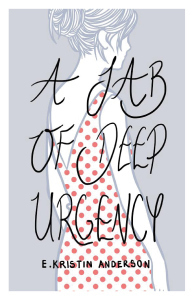
Finishing Line Press, October 2014.
With the hopes of getting all y’all to pre-order copies of my forthcoming chapbook A JAB OF DEEP URGENCY, I am offering thank you gifts. And those thank you gifts come with some sweet, sweet membership. Anyone who receives a pre-order gift from me — and, to be clear, anyone who pre-orders and emails me their proof of purchase will receive said gift — is an official member of the #UrgencySquad.
#UrgencySquad kits will contain the following:
1. A letter from me! Which might not be that exciting, but the letter does include your mission, should you choose to accept it. Also, some thank yous.
2. One page from Jennifer Egan’s A VISIT FROM THE GOON SQUAD, chosen at random. My new chapbook was created using Ms. Egan’s novel, as you know. So, I’m giving you a page of your own.
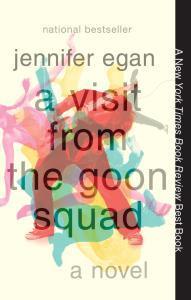
Anchor, Paperback Edition, March 2011.
3. A few other source texts. (Can you see where this is going?) You might be getting a magazine article, the back of a cereal box, or breaking news. Or all of the above. Or other texts altogether. IT’S A MYSTERY.
4. Glitter. Okay, fine, confetti. Because I hear some people don’t like vacuuming glitter out of their carpets.
5. A crash course on found poetry, complete with links to resources and examples. To help you in your mission. (Should you choose to accept it.)
6. SWAG! I’ll be sending signed post cards, and I’m currently collecting promotional swag from other writers of found poetry. So, yes, you will be swaggified.
SO. Are you ready to join? Become a member of the #UrgencySquad by pre-ordering A JAB OF DEEP URGENCY from Finishing Line Press. After you order, send me proof of your purchase (you can forward your receipt or take a screen cap of your completed order) by email to e.kristin.andersonATgmailDOTcom. Make sure to include your mailing address! I’ll put you on the list to receive your #UrgencySquad kit. They will be mailing out in August.
…and guess what? I don’t care WHERE you live! If your country will let me send things to you, I’ll send them. Because the #UrgencySquad is about having fun and making art, but it’s also very much about thanks. So thanks, y’all! I can’t wait to post pics as I assemble these kits. Because…I have already found confetti in my shoes today. It can only get better, right?





July 21, 2014
Review: THE GIRL FROM THE WELL by Rin Chupeco
I’ve long been a fan of Japanese horror films like The Ring and Ju-On (remade in the US as The Grudge). So if that’s the kind of spooky stuff you like, I bet you’ll dig Rin Chupeco‘s debut novel THE GIRL FROM THE WELL.
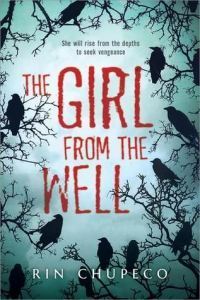
Sourcebooks Fire, August 2014.
The book opens with Okiku stalking her prey — Okiku being the ghost of a murdered teenager and her prey being the murderer of a small child. Okiku has a thirst for blood, but, in the centuries since her death, she’s found a way to sate that thirst without harming innocents. And she’s been on this path for years, without spending much time getting to know the living around her. Until she meets Tark, a boy who hides strange tattoos with long sleeves. Following him, she discovers that the tattooed boy is haunted by more than his tats — there’s a strange spirit attached to him. And soon Okiku is attached to him and his family — emotionally.
Deftly weaving traditional Japanese folklore into a modern narrative, THE GIRL FROM THE WELL is a real page-turner. This is the kind of book that keeps you up at night, not only because it’s super scary, but also because the suspense is so tightly wound. So, horror lovers, this one’s for you. Make sure you’ve got a flashlight before you flip to page one.





July 18, 2014
Review: BROKEN WORLDS by Anitha Robinson
In BROKEN WORLDS by Anitha Robinson, teenage runaway Kalli thinks she’s escaped the worst. Sure, she’s living on the streets, but at least she’s not being preyed upon in her own home. And, with her young friend Sammy at her side, she is trying her best to start over. But everything changes when she’s attacked in an ally and the man who comes to her rescue is anything but average.
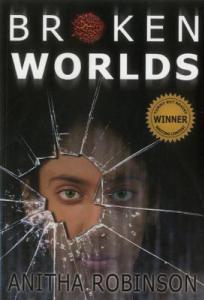
CBAY Books, June 2014.
When she wakes up, Kalli isn’t in a regular hospital. The healer who treated her is strange, but successful, leaving almost no scars where she should still have cuts and bruises. The only thing that makes her feel safe is her rescuer, Ellis. She’d thought he was an angel, but has since realized how silly that is. Soon she finds herself staying with Ellis while she recovers. She knows it’s bizarre, but she feels a bond with Ellis, who isn’t much older than her, but seems more independent than most nineteen-year-olds. It seems like an impossible fantasy, her staying with this amazing guy, until she starts to remember things that don’t make sense. She’s soon caught up in a dramatic plot – a plot that is so far from the world she knew that she isn’t sure she’ll survive it. Betrayed and terrified, Kalli is soon unsure if she can trust Ellis — or anyone — ever again.
A fast-paced thriller, BROKEN WORLDS dares to tackle the topic of abuse while engaging readers with mystery and adventure. This is a great read for fans of campy sci fi shows like Starcrossed and Roswell. And, as a bonus? Anitha Robinson definitely knows how to write a great kiss!





July 17, 2014
Review: THE TRUTH ABOUT ALICE by Jennifer Mathieu
It’s been a while since I read a book that was this beautiful and intense. THE TRUTH ABOUT ALICE by Jennifer Mathieu is brilliant and heartbreaking, and it’s a book that you definitely don’t want to miss.
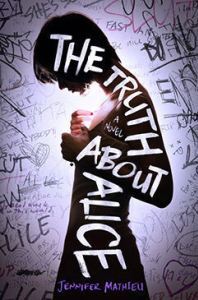
Roaring Brook Press, June 2014.
Told from four points of view — none of which, by the way, is Alice, this is the story of how one high school became completely obsessed with one girl: Alice Franklin. Who is supposedly responsible for the car crash that killed the popular football star, Brandon. Whose name — along with increasingly disgusting rumors — adorns the “slut stall” in the girl’s bathroom. And as the tension rises, it’s not only Alice’s “truths” that are revealed, but also the truths about the four students who tell her story — Alice’s former best friend, the dead football player’s closest ally, the school’s queen bee, and the genius nerd — the only person with the courage to reach out to the now-outcast Alice Franklin.
THE TRUTH ABOUT ALICE is a short book, but it packs a punch. And I wish it weren’t a story that we need, but it is. THE TRUTH ABOUT ALICE is, honestly, the truth of many teens’ experiences. Jennifer Mathieu is a powerful writer, and I can’t wait to see what she comes up with next.






